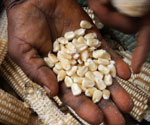Project dates: 2006 to 2011
 In East Africa, maize is an important staple crop and is seen as a vital part of food security.
In East Africa, maize is an important staple crop and is seen as a vital part of food security.
This project examined the various options for farmers in the region – from choosing alternative crops, to using new techniques or technology. It looked at how farmers and others see and make these choices in the context of climate change, uncertain markets and changes in land use. It also looked at the assumptions and framings behind various interventions and proposals by governments, researchers, aid donors and private companies. The project ran from 2006 to 2011.
Finding alternatives
80% of the population of Kenya rely on agriculture. Maize is never far from the headlines, and is a politically-charged topic. Agricultural research and development policy focus on improving maize production. There is a virtual “lock-in” to maize as the dominant pathway to food security.
Our research focused on Sakai, a risk-prone, low-potential area in Kenya. We used Multicriteria Mapping (MCM) to explore how farmers and others involved in maize could develop and envisage alternative pathways. These included growing alternative crops, improving the maize seed itself, and using new seed varieties.
We found that the growing concern with climate change could be an opportunity to challenge conventional practices. However, obstacles remain: for example, farmers’ concerns about their ability to sell different produce, and the reluctance of agro-dealers to grow root crops such as sweet potato and cassava.
Briefings
- Pathways in and out of maize by John Thompson
Briefing series: findings from the Maize project
1: Environmental Change and Maize Innovation Pathways in Kenya: Seeking Resilience through Diversity
2: The STEPS Pathways Approach
3: MCM (Multi-Criteria Mapping) Maize Project Method
4: Maize Security does not equal Food Security? Breaking the ‘Lock in’ to the Dominant Maize Pathway
5: Orphans or Siblings? Opportunities and Constraints in Alternative Dryland Staple Crops
6: Living in Parallel Worlds? Bridging Formal and Informal Seed Systems
7: Getting the Value Without the High Risk? The Rise of Horticulture in Sakai
Working papers
Environmental Change and Maize Innovation in Kenya: Pathways in and out of Maize
STEPS members working on this project
- John Thompson – Convenor
- Sally Brooks – Research Officer
- Erik Millstone – Research Fellow
STEPS partners on this project
- African Centre for Technology Studies, Nairobi, Kenya (ACTS)
Serah Nderitu (Phase I) and Andrew Adwera (Phase II) - Centre for African Bio-Entrepreneurship, Nairobi, Kenya (CABE)
Hannington Odame - Tegemeo Institute of Agricultural Policy and Development, Egerton University, Nairobi, Kenya
Betty Kibaara (Phase I) and Francis Karin (Phase II)
Related Research and events
- “How might agricultural biotechnology help poor farmers in Developing Countries?” Presentation by Erik Millstone to the Royal Society of Chemistry and Institute for Food Science & Technology, February 2010
- Farmer First Revisited
Films
“Pathways in and out of Maize” (26 minutes) explores how maize farmers are living with environmental change and food insecurity in Kenya. It was shown to a group of stakeholders in Kenya as part of our project.
“Seeds and Sustainability: Maize pathways in Kenya” (4 minutes) is a shorter introduction to the STEPS pathways approach through the voices of a farmer, a scientist, a regulator and a seed policy analyst. A longer 20-minute version is also available.